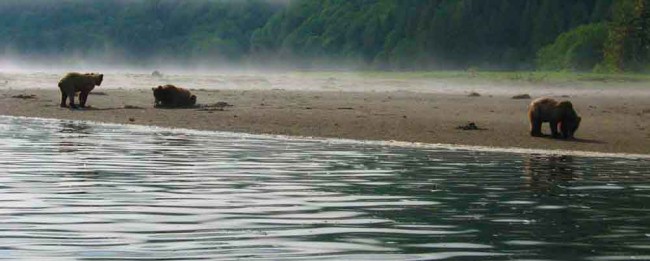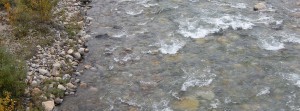
Photo Credit: courtesy of BC Parks
Postcard Parks: Exploring & camping in northern BC
The days are getting longer. The warmth of the sun is starting to break through the wall of winter. What will you do with the extra hours of light, the warmth, that sense of the world opening itself up to possibility?
Road trip perhaps? A hike to see new growth pushing through the melting snow? Or maybe that big adventure you’ve been planning all winter? Every year, the landscape opens up again and with it comes a sense of freedom—the possibilities for exploration are infinite.
For most, camping is a spring and summer thing. All across this vast region are parks and protected areas managed by the BC government. Some are small, perfect places for weekend-warrior camping, with good amenities and drive-in sites; others are seemingly endless tracts of rugged landscape, where you can set out with a pack and disappear for days, if not weeks.
It would take every page of this magazine to cover all the parks in northern BC, so this is just a small sampling. To find out more about any of these parks or explore other ideas, head over to www.env.gov.bc.ca/bcparks.
North Coast
Waking up to the sound of surf rolling in on a beach is a unique pleasure. On the archipelago of Haida Gwaii, the camping is exquisite. Free from snow most—if not all—of the year, Haida Gwaii has plenty of options for exploration from a tent.
Naikoon Provincial Park is a great place to start. Covering a sizeable chunk of the northeast part of Graham Island, Naikoon has two official campgrounds—Agate Beach and Misty Meadows—and includes North Beach, Rose Spit Ecological Reserve and several amazing trails. You can camp on North Beach for free, but you have to be self-sufficient and always remember to respect the natural ecosystem.
On the other side of the Hecate Strait sits one of BC’s most extraordinary parks: the Khutzeymateen Grizzly Sanctuary. It’s a special place. Human use of the park is limited and strictly controlled to protect its grizzly bear population. Trips into the park are typically arranged through a registered, park-sanctioned guide and are limited to boat access only. If this is an article about camping, you ask, why include a park that doesn’t allow camping? Well, because it’s amazing and you should go.
Here’s the plan: catch a boat out to the Khutzeymateen to immerse yourself in the world of bears and when you’re done, take a short drive to Prudhomme Lake Provincial Park, just outside Prince Rupert, where you’ll find a welcome place to pitch a tent.
Terrace
Anhluut’ukwsim Laxmihl Angwinga’asanskwhl Nisga’a, also known as Nisga’a Memorial Lava Bed Provincial Park, is jointly managed by the BC government and the Nisga’a First Nation. About 100 km north of Terrace, the park is a mix of natural history, namely, volcanic activity—one of the most recent examples in Canadian geological history—and cultural history.
Because the volcano spewed immense lava flows so recently (only 250 years ago) this terrifying natural event features prominently in Nisga’a stories, mythology, legend and history. The lava flow destroyed two villages and took the lives of 2,000 people. What’s left is a combination of gripping stories and a spectacular landscape of incredible volcanic features. Add the Nass River, epic mountains, flora and fauna, and you’ve got the makings of a memorable camping trip.
South of Terrace, about halfway down Highway 37 to Kitimat, is one of the most popular camping and boating sites in the area. Lakelse Lake is much loved by visitors, travellers and locals alike. It’s part of the Skeena River watershed and boasts an impressive population of old-growth trees—cedar, Sitka spruce and hemlock. The lake is great for swimming in summer, the campgrounds have plenty of amenities and the park has a number of trails to hike.
Northern
You don’t ever forget Mount Edziza. If you happen to meet someone who has been there and engage them in conversation about the park, their eyes tend to glaze over a little bit and their voice catches a wistful wind of excitement.
The park covers a vast landscape, much of which is in the alpine. The mountain itself is a dormant volcano and the evidence of its eruption covers an immense plateau: a desolately beautiful place. While there are some limited camping amenities at Buckley and Mowdade lakes (including bear caches), this is a true backcountry wilderness where visitors have to be skilled, knowledgeable, self-sufficient and prepared for encounters with wildlife. Typically accessed by floatplane, Mount Edziza is the northern adventure and one well worth all the required planning.
Farther north, shortly before you hit the BC-Yukon border, is a little place called Boya Lake Provincial Park. You probably wouldn’t come here unless you were on a road trip up to the Yukon or Alaska, but if you are making that journey, it’s a great spot to spend a night. The lake is sublime and its remoteness instils a feeling of timelessness, set smack dab in the middle of a great wild expanse. With plenty of drive-in campsites and a few spots to launch a canoe, Boya Lake is a place you should write into your itinerary if you’re heading north.
To get to Tatshenshini-Alsek Provincial Park, you have to either drive up through the Yukon (passing Boya Lake on the way) or catch a ferry to Alaska and make your way from Haines or Skagway. The triangular-shaped park is in British Columbia, however, and is home to BC’s highest peak—the incongruously named Mount Fairweather.
The effort getting here will be rewarded. Together with bordering parks in the Yukon and Alaska, Tatshenshini-Alsek is part of a UNESCO World Heritage Site, the largest protected area in the world. Big mountains, sprawling glaciers and pristine rivers protected from source to sea are what set this place apart.
Bulkley Valley
The Bulkley Valley has numerous provincial parks with great trails, lakes, rivers, mountains and campgrounds—a smorgasbord of outdoor recreation opportunities. One of the largest parks in the area is the Babine Mountains. East of Smithers, the park covers over 31,000 hectares with trails ranging from day hikes to multi-day treks. The Silverking Basin boasts the idyllic Joe L’Orsa backcountry cabin and wilderness camping is allowed throughout the park.
Folks looking for a bit of adventure might consider paddling the lake chain in Nenikëkh/Nanika-Kidprice Provincial Park, near Houston. It’s a spectacular place where travellers will discover a well-defined canoe route with portage trails and wilderness campsites along the way. The views are memorable, to say the least.
For a spot offering well-maintained campsites with amenities and easy access to groceries and supplies, check out Tyhee Lake, in Telkwa. Not far off Highway 16, Tyhee Lake is a great place to set up shop for a night or a few days while you explore the area. It’s perfect for swimming, boating and spending time with friends, old or new.
Interior
Beaumont Provincial Park between Burns Lake and Prince George, on the shores of Fraser Lake and not far from the lake’s namesake town, is an ideal spot for fishing, boating, swimming, windsurfing (Fraser Lake is known for steady winds) and, of course, family-friendly camping during the summer season (May 15 to Sept. 14).
In the Uncha Mountain Red Hills Provincial Park, on the shores of Francois Lake, travellers will find a unique landscape and a great place to hike. Its location features a microclimate that encourages a variety of ecosystems to flourish, including grasslands and low-elevation old-growth forests. There are no designated camping areas here, but visitors are welcome to camp in the backcountry, taking care to respect these rare ecosystems and all their associated plant and animal life.
Prince George
A short drive east from Prince George, Purden Lake is a natural refuge from the hustle of city life. Popular with locals, the park features a large campground, boating, fishing and swimming opportunities, as well as lakeside trails.
North of the city is another great spot for camping and exploring: Crooked River Provincial Park. The sandy beaches at Bear Lake are popular with families and three short trails provide an opportunity to explore the lodgepole pine forest, stretch your legs and look for birds and other wildlife. Crooked River features in the historic travels of both Alexander Mackenzie and Simon Fraser.
Alaska Highway
Heading up the Alaska Highway is a rite of passage for many people. Americans from the “Lower 48” (as Alaskans refer to the rest of the country) are particularly drawn to the route, exploring its history and epic landscapes simultaneously. Oh, and they are indeed epic. Coming from the south, after you pass through Fort Nelson, you’ll hit Stone Mountain Provincial Park and its bordering neighbour, the Northern Rocky Mountains Provincial Park.
The Rockies are incredible wherever you experience them, but up here it’s different. The biggest difference is population, both local and transient. Here, instead of a bevvy of tourists snapping shots of peaks and glaciers and lakes, as you’ll often see in Jasper or Banff, you’ll find almost no humans at all. And yet, the landscape is strikingly similar to its southern counterparts—in other words, jaw-dropping.
It’s a wild place (there are no campsites or amenities in this park) so if you intend to explore by foot, boat or horse, plan your trip well and stay safe.
Not much farther north, and bordering the Northern Rocky Mountains Provincial Park, is Muncho Lake. Here you’ll find two official BC Parks campgrounds, from which you can stage explorations, either out on the lake or up one of the surrounding mountains.
Farther still, Liard River Hot Springs is a highlight when driving the Alaska Highway. There’s a campground, but the big attraction is the hot springs themselves. BC Parks built an elaborate system of boardwalks, benches and change rooms to accommodate the many visitors who come every year to take a dip. The structures don’t take away from the natural beauty of this place, though, and anyone passing by should definitely take the opportunity to soak in the pools.
To the east
Mount Robson is one of the most iconic views in BC. The snow-covered peak has been photographed thousands of times for publication and likely millions of times by tourists, travellers and amateur photographers alike—for good reason. The mountain looms up from its surrounding landscape, imposing and magisterial. Approaching from the west on Highway 16, the first views are enough to make you consciously pay more attention to the act of driving, because you know that it holds your gaze and, well, nobody wants to crash their car while looking at a mountain.
There are three campgrounds in the park and plenty of great trails to hike. During summer, this park can be very busy. Have a look online for information on how to book a site in advance.
















